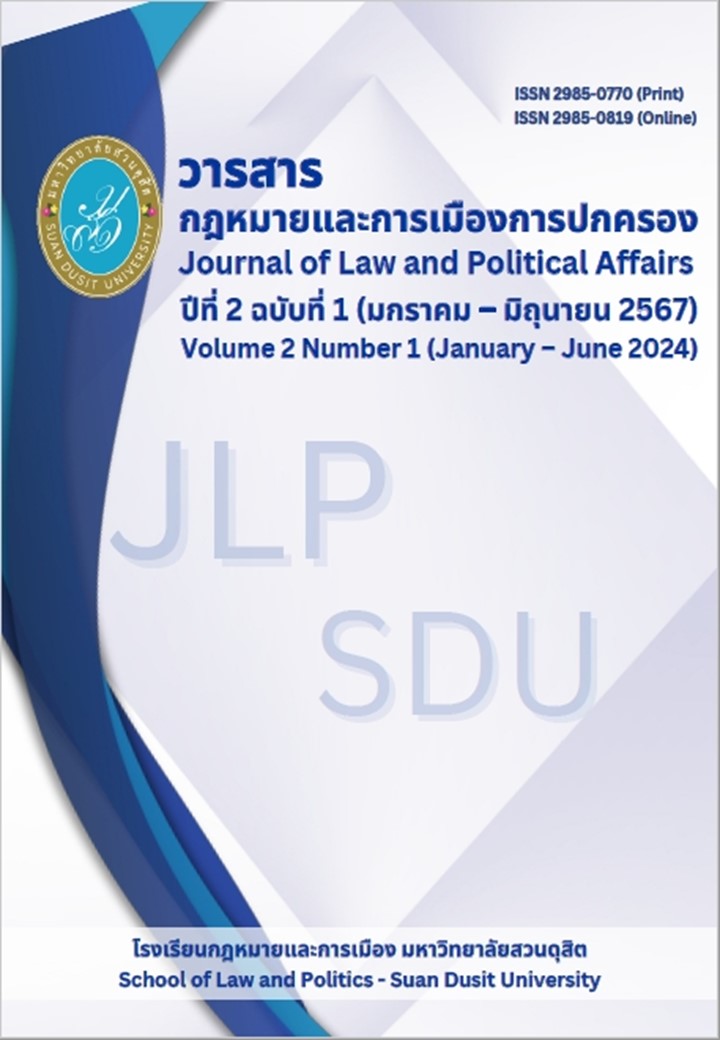Legal measures to restrain political gatherings
Sittipat Chalermyot
Keywords:
Legal measures, Political rallies, Prohibition of ralliesAbstract
The cause of political gatherings was found to be an important cause of changes in government and changes in leadership at the national level such as a coup Opposition to the succession of power by the National Council for Peace and Order (NCPO), protests to oust government leaders. The problem of law enforcement on public assemblies in Thailand is linked to many laws, from the International Covenant on Civil and Political Rights, the 2017 Constitution, the 2015 Public Assembly Act, Emergency Decree of 2005, Criminal Code and Traffic Act, etc. Therefore, the author has proposed legal measures to prevent political gatherings. There should be measures, by not using violent methods to disperse protesters who are children and youth under 17 years of age, treating the protesters as service users without committing violent acts and do not use weapons to disperse or things that cause injury to protesters, but if the protesters cause violence, measures should be taken to disperse the protest by creating a barrier to prevent access to the place and the officials. The officials and citizens should not be allowed to directly clash with each other. The laws regarding the Constitution of 2017, the Public Assembly Act of 2015, and the laws regarding mass media and news presentation shall be applied. It should be presented in a neutral format without causing provocation and do not include news content that causes choosing sides or choosing sides. Government push for the law to control gatherings to be truly raised to international standards and police officers in every area must control events equally and equitably without discrimination.
References
จุฬาพัฒน์ ช่างเกตุ. (2558). พระราชบัญญัติการชุมนุมสาธารณะ พ.ศ. 2558 . บทความนี้ใช้เพื่อนำออกอากาศทางสถานีวิทยุกระจายเสียงรัฐสภา รายการเจตนารมณ์กฎหมาย สำนักงานเลขาธิการสภาผู้แทนราษฎร. กลุ่มงานพัฒนากฎหมาย สำนักกฎหมาย สำนักงานเลขาธิการสภาผู้แทนราษฎร. กลุ่มงานพัฒนากฎหมาย สำนักกฎหมาย, สำนักงานเลขาธิการสภาผู้แทนราษฎร
พูนสุข พูนสุขเจริญ. (2565). ทบทวน 8 ปี ของการใช้กฎหมายต่อการชุมนุมสาธารณะจากคำสั่ง คสช.ถึง พ.ร.ก.ฉุกเฉินฯ. ออนไลน์ https://tlhr2014.com/archives/42168.
รัฐธรรมนูญแห่งราชอาณาจักรไทย พุทธศักราช 2560 , มาตรา 44 ราชกิจจานุเบกษา เล่มที่ 134 ตอนที่ 40 ก,
(6 เมษายน 2560), 12
ยุทธพร อิสรชัย,(2021). สิทธิในเสรีภาพการชุมนุม. เข้าถึงเมื่อ 20 สิงหาคม 2564 จาก https://www.amnesty.or.th/our-work/assembly/.
ยุทธพร อิสรชัย. (2561). การชุมนุมทางการเมือง. สถาบันประปกเกล้า บทความออนไลน์ wiki.kpi.ac.th/ index.php?title=การชุมนุมทางการเมือง.
iLaw, (2565). การชุมนุมปี 2563 พริบตาแห่งความเปลี่ยนแปลง: พลังก่อตัวจากไหน มีพัฒนาการอย่างไร เราเจออะไรมาบ้าง. ออนไลน์ https://www.ilaw.or.th/articles/10090.
Downloads
Published
How to Cite
Issue
Section
License
Copyright (c) 2024 School of Laws and Politics, Suan Dusit University

This work is licensed under a Creative Commons Attribution-NonCommercial-NoDerivatives 4.0 International License.
ลิขสิทธิ์ต้นฉบับที่ได้รับการตีพิมพ์ในวารสารกฎหมายและการเมืองการปกครอง มหาวิทยาลัยสวนดุสิต ห้ามผู้ใดนำข้อความทั้งหมดหรือบางส่วนไปพิมพ์ซ้ำ เว้นแต่จะได้รับอนุญาตอย่างเป็นลายลักษณ์อักษรจากโรงเรียนกฎหมายและการเมือง มหาวิทยาลัยสวนดุสิต นอกจากนี้ เนื้อหาที่ปรากฎในบทความเป็นความรับผิดชอบของผู้เขียน ทั้งนี้ไม่รวมความผิดพลาดอันเกิดจากเทคนิคการพิมพ์







